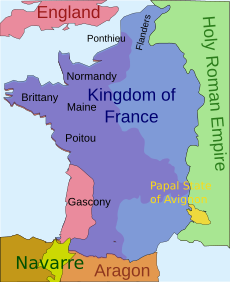Battle of Lunalonge facts for kids
Quick facts for kids Battle of Lunalonge |
|||||||
|---|---|---|---|---|---|---|---|
| Part of Hundred Years' War | |||||||
|
|||||||
| Belligerents | |||||||
| France | Anglo-Gascons | ||||||
| Commanders and leaders | |||||||
| Jean de Lille, Seneschal of Poitou (POW) | Thomas Coke, Seneschal of Gascony | ||||||
| Strength | |||||||
| Approx 1,500 | Approx 500 | ||||||
| Casualties and losses | |||||||
| 300 killed plus others captured | Light, but all horses lost and baggage looted | ||||||
The Battle of Lunalonge was a fight that happened in the summer of 1349. It was part of the Hundred Years' War, a very long conflict between England and France. About 1,500 French soldiers fought against 500 Anglo-Gascon soldiers. The battle likely took place near modern Limalonges in France.
Even though they were outnumbered, the Anglo-Gascons won the battle. Their leader was Thomas Coke. The French, led by Jean de Lille, managed to capture the Anglo-Gascons' horses. This meant the winners had to walk away from the battle. The French lost around 300 men, and many were captured, including their leader.
Why the Battle Happened
For a long time, English kings also owned land in France. This made them like a tenant (vassal) to the French king. This situation often caused arguments between the two countries. French kings wanted to take back these lands. By 1337, England only controlled Gascony in southwest France. They also held a small area called Ponthieu in northern France.
Gascony was important because it produced a lot of red wine. This wine was sold to England, bringing in much money for the English king. The people of Gascony preferred being linked to the distant English king. He usually left them alone. The French king, however, would often interfere in their lives.
In 1337, the French king, Philip VI, decided to take back Gascony. He said the English king, Edward III, had not followed his duties as a vassal. This event started the Hundred Years' War. Even though Gascony was the main reason for the war, England often focused its armies in northern France. This meant Gascony had to defend itself for many years.
Leading Up to the Fight
In November 1348, England and France agreed to a temporary peace called the Truce of Calais. This truce was extended in May 1349. However, in southwest France, people mostly ignored it. Many small battles and raids continued throughout the summer of 1349.
Jean de Lille, a French commander, gathered soldiers from his area. He planned to attack the Anglo-Gascon castle of Lusignan. In late May, Thomas Coke, the Anglo-Gascon commander, led 500 mounted soldiers from Bordeaux. Most of these soldiers were from Gascony. They were going to help the castle at Lusignan.
On their way, they met Jean de Lille's 1,500 French soldiers at Lunalonge. This place is now called Limalonges. Among the Anglo-Gascon forces was Jean de Grailly, who later became a famous commander. On the French side was Jean le Maingre, also known as Boucicault. He later became a very important French military leader.
The Battle Begins
The French soldiers came forward in three groups on horseback. The Anglo-Gascons moved to a small hill. They got off their horses, which was a common tactic for English armies then. They sent their horses to the back, where their supplies were.
The French were careful about attacking head-on. Earlier in the war, this kind of attack had not worked well for them. Instead, they used their faster horses to ride around the Anglo-Gascons. They quickly took over the Anglo-Gascons' supply wagons and captured their horses. Then, they attacked the Anglo-Gascons from behind.
The first two French groups charged forward. But the Anglo-Gascons stood strong. They used their long spears (lances) like pikes to create a strong defense. The French attacked many times but could not break through the Anglo-Gascon formation. They lost many soldiers. The third French group did not attack. They waited for a chance to join the fight.
As night fell, no clear chance came for the third group. The French soldiers who were left, having been defeated, went back to Lusignan. They took the captured horses with them. During the battle, 300 French soldiers were killed. Many others were captured, including their leaders, Jean de Lille and Boucicault. That night, the Anglo-Gascons walked with their prisoners to a nearby fort.
What Happened Next
On their way back, Thomas Coke sent some soldiers to check out a large castle called Taillebourg. This castle was important because it controlled a main crossing point over the River Charente. These soldiers surprised the French and captured the castle in early June.
In early August, the French officially ended the Truce of Calais. Some people say this was because they lost Taillebourg. By this time, the French had stopped their attack on Lusignan castle. The next summer, a new French army captured the town of Lusignan.


